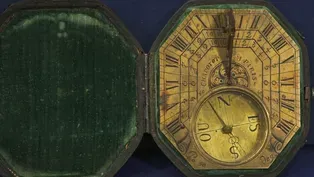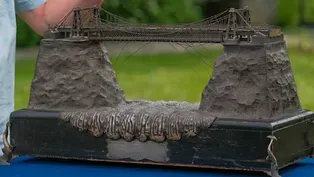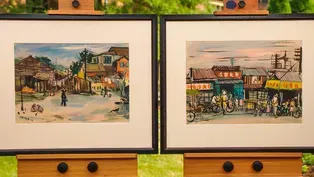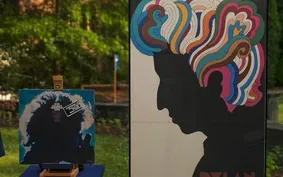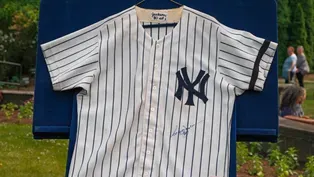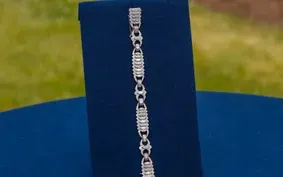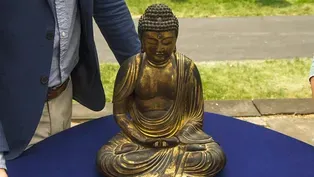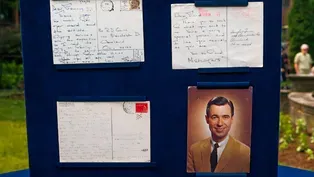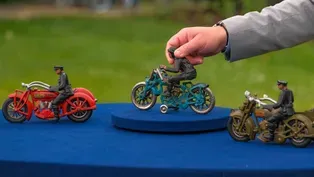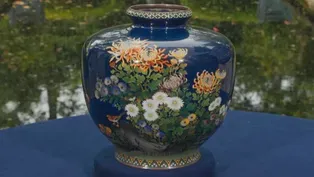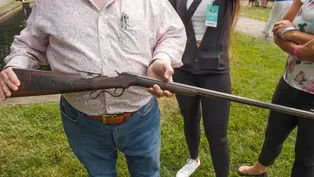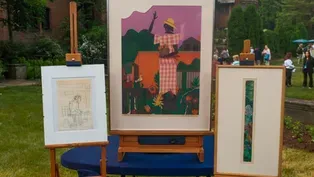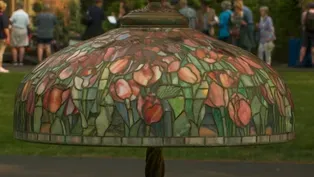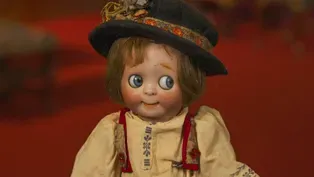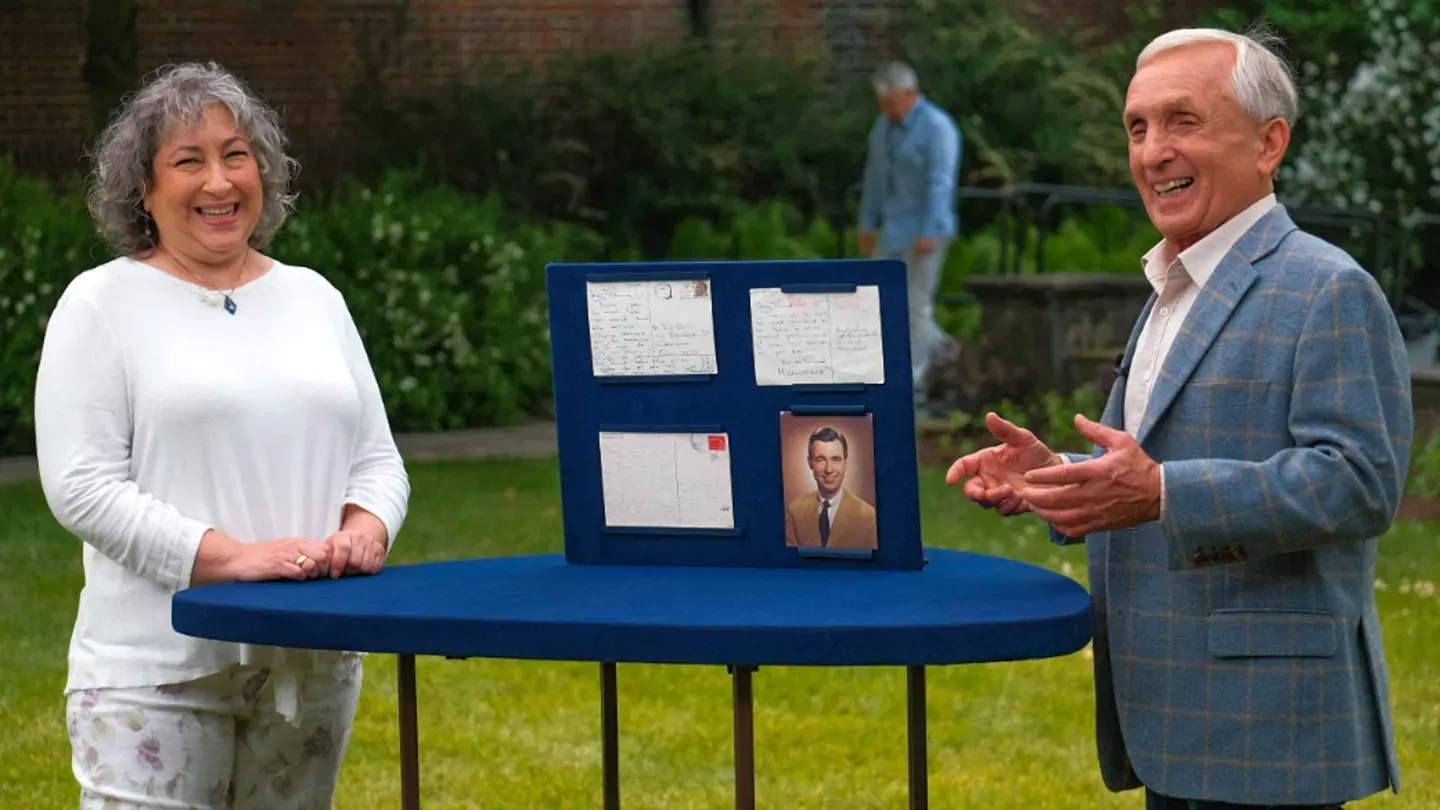

Stan Hywet Hall & Gardens, Hour 1
Season 28 Episode 13 | 52m 24sVideo has Closed Captions
Head to Stan Hywet Hall & Gardens in Akron, OH for treasures and a find up to $375,000!
Head to Stan Hywet Hall & Gardens in Akron for treasures that include Fred Rogers postcards, ca. 1968, a 1966 Milton Glaser-signed Bob Dylan poster, and a Tiffany Studios special order tulip lamp, ca. 1915. One find is $150,000 to $375,000!
Funding for ANTIQUES ROADSHOW is provided by Ancestry and American Cruise Lines. Additional funding is provided by public television viewers.

Stan Hywet Hall & Gardens, Hour 1
Season 28 Episode 13 | 52m 24sVideo has Closed Captions
Head to Stan Hywet Hall & Gardens in Akron for treasures that include Fred Rogers postcards, ca. 1968, a 1966 Milton Glaser-signed Bob Dylan poster, and a Tiffany Studios special order tulip lamp, ca. 1915. One find is $150,000 to $375,000!
How to Watch Antiques Roadshow
Antiques Roadshow is available to stream on pbs.org and the free PBS App, available on iPhone, Apple TV, Android TV, Android smartphones, Amazon Fire TV, Amazon Fire Tablet, Roku, Samsung Smart TV, and Vizio.
Buy Now

ANTIQUES ROADSHOW 2025 Tour!
Enter now for a chance to win free tickets to ANTIQUES ROADSHOW's 2025 Tour! Plus, see which cities we're headed to!Providing Support for PBS.org
Learn Moreabout PBS online sponsorship♪ ♪ CORAL PEÑA: "Roadshow" is discovering where the rubber meets the road in former rubber capital of the world Akron, Ohio.
It's what a friend of mine calls "righteous patina."
(guest laughs) APPRAISER: When you bought this, it must've been a wonderful day in the neighborhood.
That's the superhero of public television.
♪ ♪ PEÑA: Stan Hywet Hall and Gardens, the former grand estate of the Seiberling family, is a big draw for visitors to Akron today.
The Seiberling family's fortune stemmed from the rubber industry.
Frank Augustus Seiberling, called F.A., was a co-founder of the Goodyear Tire and Rubber Company, and later on, the owner of the Seiberling Rubber Company.
Stan Hywet became home for the Seiberlings in December 1915, and for the next 40 years, the estate was the hub of social activity for the large, close-knit Seiberling family, and full of celebrations with local and national movers and shakers, like Helen Keller and former president William Howard Taft.
F.A.
's wife, Gertrude, died in 1946, and F.A.
in 1955, after which their heirs turned Stan Hywet into a nonprofit historic house museum.
What history will be uncovered at "Roadshow" today?
Take a look.
(laughs) How you all doing?
♪ ♪ Hi!
(laughing) WOMAN: Might be our youngest guest yet.
I know.
(all laugh) ♪ ♪ Um, this was my maternal grandparents'.
They got it shortly after they were married in the late '40s.
Um, my family's just guarded this ever since.
There's a couple markings here, but other than that, we have no idea, so we're hoping to find out today.
MAN: Does it work?
I have no idea.
(guest and man laugh) And I, I don't care to know, either.
So I brought an Amida Buddha, which I believe is from the Edo period.
My husband's great-grandparents brought it over from Japan in 1917.
When his grandfather passed away in 2000, we obtained it, and we've been having him sitting in our dining room facing east for 23...
Very good.
(laughing): For 23 years.
(laughs): Nice.
You are absolutely correct in all the things that you do know.
Oh, okay.
But I wonder if there's a few things maybe I can, I can help... Yeah, please.
...and, uh, provide a little enlightenment of my own.
Although this is a paragon of enlightenment, naturally.
The Amida Buddha, specifically very revered in Japan, is the Buddha of, of everlasting life and all-encompassing light.
Mm-hmm.
And so it's a tremendous sort of image in, in a home shrine or in a shrine in the community, to see this image of the Buddha.
Even though this is not one of the more ornate Buddhas... Mm-hmm.
...I can illustrate that this Buddha's hand gesture is one of, of serenity, peace, and contemplation.
The clarity of the vision of the third eye here... Mm-hmm.
...is, is really sort of exemplified in the, this fine piece of rock crystal, which is, which is set.
So this dates from the early part of the 18th century in Japan, and it's very, very typical of Edo period wood carvings.
It's, it's lacquered and then gilded.
So this is gilt lacquer on wood.
Your Buddha is showing a little bit of age, naturally, and that's to be expected.
Mm-hmm, yeah.
But I think that actually lends to the, to the overall majesty of the, of the carving.
When we try to, to age the, the objects that we see, there's... We looked at, are the, are the wear patterns consistent with genuine wear, or has it been tinkered with a little bit?
Sure.
But I think here, you see it's in the right place, which is a good thing.
A little bit of cracking to the lacquer.
Yeah.
A little bit of cracking to the wood.
Wouldn't worry about it, all right?
Okay.
Now, you've learned a great deal, and you've honored and loved this for a while, but there's a little secret within that I bet you don't know.
I don't know any secrets about it.
'Cause it... (laughs) (chuckling): Well, I...
I'll give you a clue, and I'll be gentle in doing this.
Okay.
But I wonder if you've ever come to realize... (statue rattling) Oh, yes, I have heard that, yes.
Okay.
Before these Buddhas were placed in their respective shrines... Mm-hmm.
And this is not just a Japanese custom, but one throughout the, the, the East Asian Buddhist world, they were consecrated, and to consecrate these was to take prayer scrolls and to insert them into the cavity of the Buddha.
(gasps softly) Now, if this were from some particular nations, we would find a, a hatch, sort of a "trap door" on the back, where it had been placed.
Uh-huh.
Not so here.
Okay.
We looked at it, my colleagues and I, and what we came to discover, there's actually a, a little door in here.
(laughs) Did you, have you ever noticed this sort of woven fabric that's put over?
Oh, yeah.
Can you feel the, the texture on that?
Yeah.
And then it's lacquered over?
That's kind of sealing off the, the cavity.
Oh, okay.
And so, it's not worth busting it open.
I wouldn't dare do that.
No, no, no, no-- no.
But there would be, I think that little rattle... Ah.
...is a prayer scroll that is inside.
Oh, wow.
So, meaning that it is fully intact, and... (chuckles) ... fully sort of ready to fulfill its purpose.
Oh, wow.
You know, inspiring those in Japan, and I might say probably inspiring you a little bit in your home.
Yeah, absolutely, yes.
It being of considerable age, considerably good quality, and just of striking appearance, I think at auction today, I would place what is perhaps a conservative auction estimate of $3,000 to $5,000.
Oh, wow, that's great.
(laughs) Thank you so much for bringing it in.
Thank you.
We love it.
(chuckles) I went to a local auction in my neighborhood.
I was bidding on what I thought was just a single postcard for Valentine's Day, Victorian era, and nobody bid against me, so I won for one dollar.
And I picked up the postcard, and they're, like, "Whoa, whoa, whoa.
No, you won the whole box."
So I got a shoebox full of somebody's life, and there was these postcards in it.
And when I saw Fred Rogers, I thought, "That's the superhero of public television.
That's got to be something very special."
And when I started to read the correspondence, it's by him, in his hand, and he's writing to what I think is some family, and he's, um, asking about how they're doing, and, "Hey, do you think there's any market in the Cleveland area for my new show?"
So I thought, "Wow."
Well, I guess I can't help but say this, but it must have been a wonderful day in the neighborhood when, when... (laughs) ...when you bought that box of material.
Mr. Rogers is obviously so iconic.
One of the things that's really, really nice about these postcards is, they're in the mid-'60s.
He started in television, children's television, in the '50s.
He actually went to Canada, and in the early '60s, had the "MisteRogers" show.
And he finally came back from Canada, and went to WQED in Pittsburgh in 1966 and started "Mister Rogers' Neighborhood."
In this, he mentions ETV.
They were a small network of Eastern public television stations to share shows.
What he's saying in one of the letters that I particularly like, he was saying, "Okay, we have a few stations "that have picked the show up in the Eastern educational, but do you think maybe Cleveland would pick it up?"
(chuckles) Because they were obviously in Ohio.
"I'd really like to see the show get expanded."
And then, a few years later, 1970, is when public television, PBS, picked up the show, and that's when it started to really skyrocket.
First of all, they're all signed, and this one is signed "Misterogers," "your friend."
Now, the picture is wonderful, and it's what caught my eye.
There's nothing written on the back of this.
You got your money back.
(laughs): My dollar?
The dollar, the... You got your dollar back with this picture.
Okay, fair.
But...
There are pictures on the other side of these.
But two of 'em are the same, one's slightly different.
Mr. Rogers signatures, especially where he's talking about his early career, talking about the problems of the show-- thinking about the idea that, if they didn't pick it up, what we would have missed, the three letters, I would say, conservatively, on a retail value, is $1,500 to $2,500, conservatively, as a package.
And they're just so much fun, I, I mean, what can you say?
(laughs) Well, my son and his buddies liked to collect baseball cards.
And I was always driving them, 'cause they were too young to drive anyplace.
And one of the places nearby had a special event that day, and they said, "Put your name in a, "in a slip and stick it in the box, and we'll have some drawings."
And lo and behold, I won this.
Did you have to pay to enter the drawing?
Nope, all I had to do was put my name on a piece of paper and drop it in the box.
When I won, they called and said, "You got the jersey."
Cool.
(chuckles) Did they tell you anything else about the jersey at the time?
Nope.
Really?
They said they thought it was probably worth about a couple hundred dollars, but that's all they said.
Okay.
They just said, "Enjoy."
Excellent.
And I says, "Well, thank you."
(chuckles) Sure.
The good news is, is that all of the labels and all of the stitching are spot-on for what it should be.
All right.
Okay, so let's look at the label at the top.
Okay.
It says "Jackson."
Uh-huh.
So we know it's Reggie Jackson.
Mm-hmm.
We know it was issued to him and worn.
We have all this great wear, including a couple of stains here at the bottom.
Mm-hmm.
That's nice.
We like game-worn jerseys.
We like people's dirty laundry.
(chuckling): Of course.
Of course.
Shows it was really used.
"80, set 1" tells us that it dates to 1980.
Oh, okay.
So we have the New York Yankees insignia.
We have Reggie Jackson and his number 44, signed.
We also have the Wilson tag with his size.
Okay.
And everything seems to be just perfect.
His number 44 is on the reverse, as well.
Mm-hmm.
So we have no doubt that this is a 1980 Reggie Jackson New York Yankees game-worn jersey.
All right, fantastic.
What also tells us is that it's 1980 is the black band, the black stripe on the left arm.
That was in memorance of Thurman Munson.
Oh!
Thurman Munson was a teammate-- yes.
Right, okay.
And he was tragically killed in a small plane crash the year before, in '79.
What happened in 1980?
Well, the Yankees didn't win the World Series, but Reggie Jackson had a great year.
He won the Silver Slugger Award.
He was the American League home run leader that year, he hit 41 home runs.
And when people are collecting things, in the connoisseurship of good, better, best, this is pretty good.
All right.
So we looked at what set number two sold for.
And, um, set number two actually sold at auction for just over $5,000 in 2012.
Oh.
Okay?
Mm-hmm.
So today, an auction estimate for this jersey would be $8,000 to $12,000.
Oh, my gosh.
(laughing): That's amazing.
(chuckles) Wow.
Yes.
Do you know why he was number 44?
He was, like, "I'd like number 44 because I want to pay homage to Hank Aaron."
Well, this is my wife's grandfather's grandfather's.
Uh, it is a baby bouncer.
My wife, her sister, brother, um, her parents all bounced on it when they were kids, and here we are.
Our son sat in it about a month ago.
MAN: Your son bounced in it?
Mm-hmm.
Not-- it didn't bounce.
(laughing) Took a picture.
It was given to me from my father.
My great-grandmother brought it ho, over from Czechoslovakia and gave it to her daughter.
And when my dad was born, she gave it to my father, 'cause he was a boy, and it's a boy doll.
(chuckling): We named him Hunzi-Czech, 'cause he's from Cz... Hunzi-Czech.
'Cause he's from Czechoslovakia.
My daughters think he's creepy.
(laughing) (chuckling): Oh, those dang daughters.
But I, I think he's cute.
What are we going to do with them?
So, he's all hand-strung.
Um, his eyes move.
Okay.
I mean, he's, he's...
He's a family member.
(chuckles) He is one of your family members.
That's what I like to hear.
Your doll is actually from Germany.
Oh, is it?
And then maybe sold in Czechoslovakia as a, a souvenir doll.
He was originally made about 1910.
Ooh.
And what we really love about him is that he was made by Kestner, and he's mold 221.
And Kestner was a self- proclaimed king of doll makers, and he kind of used that to market his dolls, but he ended up really being the king of them.
He sold and made a lot of dolls.
And your doll has a, a bisque head and a composition body.
And his eyes are made of glass.
It's mouth-blown glass, and they're what we call googly eyes.
His costume was probably made in Czechoslovakia, 'cause it is... Well, that's where my grandparents were from, is Czechoslovakia.
Mm-hmm.
And then he does have on his original mohair wig and his little wool felted hat with silk flowers and beautiful embroidered ribbon.
And then the other thing we s, talk about with this doll is their grin.
Just a big, like, "I am so happy, but I'm, also might be up to a little bit of something."
His bisque head is in excellent condition, and that's where the value is.
But we've got a little damage to our toes, and that's just because it is composition.
It's just a wood product, and that's really easy, to break fingers and toes.
And we're really lucky, 'cause he has all his fingers.
It's just, we do have that toe damage.
And then he also needs a little restringing.
Mm-hmm.
Because you can see, his arms just...
Normally, you could actually hold their arms up, because that's how I like to pose 'em.
I like to pose 'em with the arms standing straight up, like, "Ta-da, here I am."
(chuckles) "Ready to start trouble."
These dolls are actually pretty hard to find.
In today's market, his retail value-- with the damage-- would be somewhere between $4,500 and $6,500.
Hm!
That's great.
(chuckles) Y, you move out of the box.
(laughing) PEÑA: Former president William Howard Taft stayed at Stan Hywet Hall in November of 1920.
Taft had been traveling the country to drum up support for the League of Nations.
A man of considerable stature in politics and in physical form, he was noted to have enjoyed breakfast with the Seiberling family.
GUEST: I brought two paintings from an artist, Shiy De jinn.
I got them both from my mother-in-law.
I had admired this painting in her house.
And when she came down to visit me, she walked in the door and, uh, handed me this roll, and rolled up inside the roll was this painting.
And then a number of years later, when she was downsizing, she gave me this painting, also.
She worked for the State Department in the '50s and '60s, and right out of college, she was stationed in Taiwan.
She actually met the artist, Shiy De jinn, at his studio.
She went with a State Department cultural officer, spoke to the artist, and bought these paintings.
So this would have been around when this painting was dated.
She was in Taiwan in 1956, I do know that.
But she was very young and she did not have much money.
She was very frugal her entire life.
Mm-hmm.
Um, so I am sure she paid very little for the paintings.
Let's talk about the artist.
He was born in 1923, on the mainland.
He was born into a wealthy family.
He studied art pretty early on.
He ended up studying with Lin Fengmian, who was one of the most important Chinese artists who blended Eastern and Western artistic traditions.
So that was a very good artistic pedigree.
Then, by 1948, he had already emigrated to Taiwan, and he stayed in Taiwan for the rest of his life.
What I see in these paintings are, this, also, blend of Eastern and Western artistic traditions, specifically in the bold line painting, providing more of a structure.
But the Western tradition here is in the contrasting colors.
Oh, okay.
He was already being influenced by Matisse and Picasso.
The medium is gouache on paper, with some ink, as well.
And the fact that it's full of activity, this was a young artist in Taiwan starting a new life.
Obviously, this is a Taiwan that's bustling, a new country being formed, really.
Yeah.
And I think he was inspired by that.
He ends up capturing a lot, including the, the electrical lines, someone here in the window, all these figures down here on their bicycles.
It just has a very kinetic sense.
Later in his career, he would paint a lot of portraiture, and then he would go on to paint a lot of landscapes.
But they were all very much showing his love for the Taiwanese landscape.
So this is someone who fell in love with Taiwan, became one of Taiwan's treasured artists.
Okay.
His auction records right now are pretty good.
Similar pieces to these have sold in the $20,000 to $30,000 range each.
Okay.
So if we were going to put auction values on these, I would put $20,000 to $30,000 on each or $40,000 to $60,000 as a group.
Wonderful.
I would probably insure them at $80,000.
Wonderful-- thank you so much.
Um, well, my dad used to work for Frito in the '90s, and I don't know how they got the trademark with Disney, but they basically had it as an incentive to set up displays for Frito-Lay with the "Toy Story" that just came out.
So we think that he probably was made in '95, when the movie came out.
So I brought an old wooden sweeper.
I found this in the attic of my garage.
We moved into our first home five years ago.
It was built in the late thir, late '30s, early '40s, and we found this in the attic.
So, have no idea much more about it other than, it has Bissell's as the name brand, and it says "American Queen" on it.
So, excited to learn a little bit more about it today.
For some reason, we felt the need to hang on to it all these years.
So, we'll see what happens.
GUEST: This is a Bob Dylan poster that was inserted into "Bob Dylan's Greatest Hits" albums in 1967.
And the poster was designed by a very famous graphic artist by the name of Milton Glaser.
Milton Glaser also designed the "I Love New York" logo.
And I have been collecting Bob Dylan, uh, memorabilia for many years now.
And, uh, I found out that Milton Glaser, back in 2018, would sign my posters if I sent them in to him.
And he just did that for free?
No, it, it was a $50 donation to one of three organizations that Mr. Glaser supported.
And I sent in my posters and, with proof of, uh, $150 donation.
And within seven days, my posters were returned, and, uh, they are signed.
Now, before you had Milton Glaser sign these, where did you get them from in the first place?
My wife and I have been antiquing for many years.
And of course, there were many times I found the album, but without the poster.
Three times, I struck gold and found the albums with the posters.
It is designed by Milton Glaser, who was really one of the great graphic designers of the late 20th century.
And the poster is one of the most beloved and most famous rock posters of all time.
And I think that, in the design world, they look at it as an icon of 20th-century design.
The poster not only looks great, it reads great.
The font, called Babyteeth, is something Milton Glaser designed, and it really stands out.
This album came out in 1967, and one year later, it went gold.
And at least 500,000 were printed in the first year.
Now, 500,000 copies of anything is a lot.
It's a lot of albums, it's a lot of royalties for Dylan, and it was a lot of posters that everybody who bought this album had, put it up on their dorm room walls.
If I'm not mistaken... (chuckling) ...if I can break the fourth wall here just for a second-- I understand that somebody who's directing this segment may have had this poster on their wall when they were growing up.
I mean, this poster was everywhere.
That's right.
When these went up on dorm room walls, when students moved to other dorms, the posters most often came down and were either thrown out or didn't move on with them.
Now, a question for you.
When you bought the album with the poster in it, how much did you pay for the album?
Ten, $15, $25.
When I did a little research just before coming out to speak to you, I found copies of the album available for sale for $50.
Mm-hmm.
And they have the, the, the sticker on it, the, the sizzle sticker that says "contains the full-color Dylan poster."
So you can buy the album and the poster for $50.
Have you ever seen a signed poster before?
Well, yes, the other two that I have.
(laughs) So a handful have come out of the woodwork.
Uh-huh.
They're all signed in the multicolor crayon.
And recently, when these posters have come up at auction, they've been estimated between $1,500 and $2,000.
(chuckling): Very nice.
Thank you very much.
You're very welcome.
It's been a wonderful experience, and, uh, I'm going to be keeping Dylan.
(chuckles) ♪ ♪ It's a vintage slot machine.
You put a penny in, and if you got three in a row, you got to win a loose cigarette from the, uh, from the arcade or the pharmacy or wherever it was located.
So you'd exchange your gumball for a, for a cig.
And that's how it worked.
My, uh, grandfather owned this, and there was gum in there, but he replaced it with marbles, 'cause the gum was getting kind of gross over the years, so...
GUEST: Well, my father was a, uh, Naval officer during the Second World War, and he went in with the first occupying forces in Japan.
He was a supply officer, and when he came home, he brought this with him.
So one of the characteristics of Japanese cloisonné-- particularly from the late 19th century and early 20th century, which is the time frame in which this was made, toward the end of the Meiji dynasty... Mm-hmm.
...is the extraordinary, fine-quality workmanship that was the standard for the very best examples.
Mm.
And this would fall into one of those kind of top ten percent of examples that you can find.
Terrific.
So, the Japanese had, were introduced to working in cloisonné at a fairly early period of time, but China was much more known for working in cloisonné.
And in the late 19th century-- I think it was around 1870-- there was a German scientist, chemist, that devised techniques... Mm-hmm.
...that vastly improved the ability to, to depict details in extraordinary fineness, and his name was Gottfried Wagner.
And we're looking at not something that he made, necessarily.
Mm-hmm.
But something that is the product of his discoveries... Ah.
...and that technological kind of leap forward that made Japanese cloisonné stand head and shoulders above any other kind of similar example.
Wow.
This ovoid jar, more or less, is the form that you get in a number of different cultures, but it's a storage vessel.
Ah.
But I promise you, this was never used for storage.
(laughing) It's really a, you know, almost a canvas on which this can be depicted, so that you get this marvelous kind of design in the front, a variety of different kinds of flowers in bloom, but you get these big, open expanses of this fabulous navy, dark blue, and then you have the birds that are in and amongst it.
And then you also get this extraordinarily fine-quality work down at the foot.
Mm-hmm.
And on top of all this, we find that the metal is silver.
Oh!
Hm!
So that's another indication of a higher quality.
And you can see there's a lot of movement in there with the flowers, these are not static, and then there's the shading of colors.
All that is done through very, very fine control of different shades of enamel paste, which are put in between the wires, the cloisons.
Wow.
And then it's fired at the end of that process, and it's polished down, and you end up with this very naturalistic appearance.
It's very fine quality.
And it's extraordinary that it survived in your family without damage, because essentially, it's glass plied over a metal base.
And I had seven brothers and sisters.
(laughs) Oh, God.
(chuckling) So it did survive.
And there wasn't, there was not an errant baseball in the house headed in that direction.
Right.
Do you have an idea?
No, none whatsoever.
Oh, you don't want to guess?
$1,000.
Try about $8,000.
Wow!
(chuckles) That would be for a replacement value, insurance value.
Yes.
I don't think any of us would've guessed that much.
PEÑA: The design of the indoor swimming pool was inspired by the Seiberling family's kids, who called it the plunge, because there's no shallow end.
There were many pool parties here, and it's been said that the pool was most cherished at Christmas, when the large, extended Seiberling family would descend on the hall.
George, what do we have here?
We have a bridge that was given to my great-great-grandfather.
It's a bridge over the Whirlpool Rapids in Niagara Falls.
My, uh, great-great-grandfather was president at the time, and the board of directors gave him this.
President of...
The Niagara Falls Bridge Company.
Oh, okay.
We have both this one and another model, which-- this is a suspension bridge, and the arch bridge we have at home, also.
And they've been just sitting on the countertop.
Well, um, you're being pretty modest about this.
(laughing) Because what this is, it's not the first bridge over the Whirlpool Rapids... Mm-hmm.
...but the second bridge over the Whirlpool Rapids.
The third bridge, which is still in existence, opened around 1897 or '98.
Okay.
But your family has been involved with all three of those bridges.
There's a plaque on the front.
Yes.
It's basically what?
"Thank you for being president."
Yeah, to your... Great-great-grandfather.
...great-grandfather, George Burrows.
Yes.
So, this was probably commissioned when the third bridge opened.
Okay.
And it was given to him in appreciation of...
The years.
...all the, all the years that he'd served with the company.
We see here an incredible scale model, but it's made out of silver.
Not wood.
(laughing): It's made out of sterling silver.
Well, that's, that's nice.
Yeah.
So it's not clear whether it was ever meant to be shiny and polished, because-- or whether it had this sort of patina.
You've never done anything to it.
No, I, I did the plaque in front so I could read it, that was it.
Yeah, yeah, and you can see in here the silver popping through... Mm-hmm.
...where people have probably touched the, the rapids here.
Hm.
And it was made by Ryrie Brothers, Toronto.
Okay.
They were jewelers and made silverware.
Okay.
So this was something that would have been made entirely by hand... Nice.
...by a silversmith working for this silver company.
This sort of detailed scale models of buildings, ships, and that sort of thing was a very sort of 19th-century thing to do.
And they're always presentation pieces for important events, like your great-great- grandfather's retirement as president of the company.
So what's it worth?
What do you think it's worth?
Knowing that it's all silver.
$1,000?
I don't know-- sentimental value is high.
I think maybe a little bit more.
Okay.
(clears throat): I think, since I...
I'm gonna assume this a, these are family pieces.
They'll never leave the family.
Mm.
I would tell you, for insurance purposes, you should insure this for $25,000.
(chuckling): Wow, that's a lot more than I thought.
Wow.
Now multiply that by two, because you have another one.
Yes.
Eh, I'm gonna have to polish 'em up, I guess, and cleanse them nice... Don't you dare polish them!
(laughs) Okay.
I won't, I won't.
(laughs) I want to emphasize that the value is not in the silver, the value is in the model itself.
Well, it was my mother's bracelet.
She took me to the jewelry store in the early '60s.
She's a widowed lady... APPRAISER: Mm-hmm.
...and she bought it for herself.
And was this a special occasion, or did she just buy it because?
No, she decided that's what she wanted.
And have you ever worn it?
Yes, I have.
Mm-hmm.
My sisters have worn it.
We've all worn it at our children's weddings.
Mm-hmm.
Oh, wonderful-- and has there ever been talk about splitting it up?
Well, when my mother passed, I did take it to a jeweler.
Mm-hmm.
He suggested that it could be taken into four pieces... Mm-hmm.
...but it would ruin its value, essentially, so...
Right, mm-hmm.
Well, we have a saying where I work is, "The greatest enemy of vintage jewelry is multiple daughters."
(both laugh) Because this often happens, that people have one wonderful piece of jewelry and four daughters, and they want to divide it up, and usually that's how vintage pieces are ruined.
But it's, so it's really good that you didn't do that, because it's far more valuable as one bracelet than as whatever you would make from its parts.
Right, well, the four of us really got along.
Uh-huh.
Mm-hmm.
And anytime anybody wanted to wear it, they'd wear it.
That's great, that's great.
Yeah.
You have such a good relationship.
It's not something you'd wear down the street, you know, to go shopping, so... (laughs) Well, it depends where, where you shop.
Right, that's true, that's true.
(laughs) And do, do you remember what year you, your mother bought it in?
It had to be the mid-'60s.
Mm-hmm.
Because I can't imagine her taking me there when I was in high school, so... (both laugh) I had to have been in college.
Mm-hmm.
Home for the summer when she did it.
Okay.
Obvious, it's really kind of a quintessential piece of 1960s design.
They loved to use these different angular-cut stones.
You can see they've used three different shapes of diamonds here.
They've used marquis-cut diamonds, which are the ones that look like, a little bit like a canoe.
Hm.
Baguette diamonds, which are the rectangular ones, and then round brilliant cuts to fill it in.
So it's really a beautiful bracelet.
The diamonds are really white, well-matched.
And the bracelet is set in platinum, which is very common for pieces from this period.
Mm-hmm.
It's not signed, but it's likely, with the style and the construction, that it was made in the United States, most likely New York.
I did a quick carat weight, and it's coming up at about 15 carats of diamonds total, which is a really significant carat weight.
And do you remember what your mother bought the bracelet for when she took you to go shopping?
Yes, she bought it for $10,000.
$10,000.
Well, you know, if you were to insure this now, I would probably suggest a value of at least $50,000.
Oh, okay, yeah, that's why we keep it in the safe.
(both laugh) Well, thank you.
Well, thank you for bringing it.
You've made my day!
(chuckling): That's what I like to hear.
Thank you.
So my grandpa owned a music store, and, um, someone had pawned this, like, 50 years ago, and he gave it to my dad.
And my dad learned how to play on this.
Pretty much all original parts.
He did have the body repainted.
And, like, this pickup was replaced, but he, he kept the original parts on it, so... Been in the family forever, and it's kind of his pride and joy.
Um, this is a poster, um, from the first Moondog Coronation Ball, on March 21, 1952, with Alan Freed-- the Big Bang of rock and roll.
I don't know a lot, um, about rock and roll history.
The Coronation Ball was, like, a big ballroom event that they made, and they oversold tickets for it.
So in Cleveland, um, I guess there was, uh, a riot, so they only got through two songs, and then the police had to break it up.
So it was one of the largest riots in Cleveland history.
GUEST: I inherited it from my grandfather in the 1970s.
None of us had seen it before he passed away, so we don't know a lot about the history.
It's a compass, has a flip-up sundial on it.
It was made in Paris, and on the back of it has the different cities in Paris and Europe, and, and how to find them on the compass.
So we think it probably is, uh, my great-great-grandfather came over to the U., the U.S. from France in the early 1800s, and so we assume it probably came down through the family, but he never told us anything about it.
I would describe it as a, as a sundial that has a compass for a very important job of helping you calibrate sort of where y, where you are, um, so you'll know what time it is.
You're right, it was made in Paris, and I'd say probably in the late, uh, 1600s, early 1700s.
What you would do is, to use the compass to calibrate for north, and then you'd be able to tell what time it was, with the markings on the back being the popular cities in Europe with their latitudes, to be able to know what time it is wherever you were.
Because it's a, a pocket size, you would carry it with you.
So these were something that were almost as common as the phones we have in our pocket today, um, back in the time period.
So you have the, the gnomon here, um, which, again, which is what's, casts the shadow.
So if you're on a, a day like today, that's pretty cloudy, or at night, they obviously were not so useful.
(chuckles): Um...
Uh, but they were really, you know, what people did, of all different types... ...of sort of socioeconomic classes, uh, whether they were merchants, um, you know, scholars traveling between locations, people involved in commerce.
So you've got these sort of a nice, these sort of enameled, um, chapters here.
The back is all engraved, and it has the, the name of the maker here, uh, Chapotot, uh, Paris, who I haven't been able to find out much about.
But this form itself is referred to as a Butterfield form.
Michael Butterfield, a British, um, watchmaker, was in Paris, and, uh, sort of designed this octagonal style in the 1680s.
And it's believed that a lot of these other, uh, makers sort of copied that popular design-- it's brass.
What's nice, too, is that this, this case is made out of, uh, sharkskin or, or shagreen.
It has sort of a waterproof, um, quality to it... Oh, wow.
...coming from the sea, um...
I didn't know that-- that's interesting.
And it's just a nice ta, feel, sort of tactile feel.
While they are, um, good survivors, the values themselves are not astronomical.
Um...
Right, right.
If you were, um, looking to insure, insure this today, you'd probably want to think about something in the $2,500 to $3,000 range.
Okay.
It's still useful... (laughs) ...if you need, need to go on a European adventure.
I think so-- that'd be a good reason to take it.
My favorite part about it is the flip-up sundial.
Yes, uh-huh.
I just think that's so totally cool.
(both chuckling) PEÑA: The Gate Lodge, a three-bedroom house, was initially used to accommodate the estate's superintendent.
By 1923, it was the home of F.A.
and Gertrude's son and daughter-in-law Fred and Henrietta Seiberling.
On Mother's Day, 1935, Henrietta was instrumental in introducing Bill Wilson and Dr. Bob Smith, whose meeting would spur the creation of Alcoholics Anonymous, an internationally known peer-led support group.
They were gifted to us directly from Romare Bearden.
My husband was an artist's assistant, and worked for him, and along the way, they got a-bonding, and he was very generous.
He gave us prints.
Oh, that's fantastic.
So we'll start with the sketch.
And how did that come about?
Okay.
This is a six-by-nine pencil sketch that, it was about 1980.
My husband, Bob, was at Romare's studio, and Romare was drawing.
Yeah.
And flipped it into re, into the receptacle, and Bob said, "Can I have it?"
So...
So he basically chucked this in the trash.
He choke, chucked it in the trash.
That's right.
It's a sketch that's not signed, but it's so natural.
Having a woman sitting by the wood-burning stove was very common theme with his work.
Yes, and how about this piece here?
Ah, that's my special one.
Ah.
This is one that was a birthday present from Romare.
Okay.
It was in 1979, and Romare had asked my husband if he wanted to go for dinner, and he said, "I can't.
"I have to take Marilyn for dinner.
For her, it's her birthday."
So Romare excused himself and brought this out to be given to me, and it says "Woman in the Garden-- for Marilyn," and it's signed.
But the one thing that I've discovered recently, "Woman in the Garden" is only Romare's title.
It had gone public as "Girl in the Garden."
Yes.
Tell me about this one.
That is an exciting one-- in the exhibit shops, Romare was working on a larger piece, and it's called "Forest Pool," and it was part of the Caribbean series.
And he cut an inch-and-a-half off the top.
And so as a thank you, he said to Bob, "I've got something for you."
It's probably the smallest collage he's ever done.
(chuckles): Yes.
As you mentioned, this is a sketch.
Yes.
And the cool thing about sketches is, it's almost like getting a writer's, uh, notebook...
Yes, yes, yes.
...and kind of seeing some of their ideas jotted down.
Even though it's not signed, it's clearly in the style, and it's a theme that he revisited numerous times.
Yes.
Yes.
And in the middle here, this piece, as you mentioned, it's, if you look it up, it's mentioned as "Girl in the Garden," right?
But this is titled "Woman in the Garden."
And then a "For Marilyn" down here.
And he signed it "Romare Bearden."
Yes.
It's interesting, too, because it's also recorded as "In the Garden," without either "woman" or "girl" in the front.
Interesting.
So it's recorded in numerous ways.
Interesting, but this is the way Romare wanted it to be, I assume.
Yes-- yes.
It's actually silk-screened on newsprint, because this was an artist's print from the printer himself.
What you're describing is what's called a B.A.T., a bon à tirer.
Ooh!
Ooh!
And that's a term...
Yes.
...used for the print that the artist makes and is, approves...
Yes.
...and, and, and is used by the printer... Mm-hmm.
...to make sure that he gets it right.
Mm-hmm, mm-hmm.
And as you said, it's on, uh, newsprint.
It's actually a color lithograph, but because it's on newsprint, it's a little more delicate in that sense.
Very much so.
Bearden was born in North Carolina.
Mm-hmm.
And when he was a small child, his family moved to New York, eventually settling into Harlem.
Mm-hmm.
But his grandparents and great-grandparents remained in North Carolina.
This is more than likely his grandmother.
Ah!
Uh, and the reason I say that is because Bearden himself wrote a poem called "Sometimes."
And in the poem, he talks about his grandmother being in the garden... Mm-hmm.
...with tiger lilies, which is what's inside this basket.
Didn't know that, yes.
Waving at passing trains, so it's kind of cool in that respect.
This is a s, is a nice, uh, small collage.
As you say, it's small, but it is a collage.
And he's famous to, as a collage artist.
Yes.
It's hard to see, but it's signed "Romare" in pencil right here.
Mm-hmm.
And so about when did you, did you get all of these items, or did he get them?
Well, let me see, the first was, um, that one was in 1975.
Okay.
These were in '79 and '80.
Ah, so by then, he's in his studio in Long Island City, right?
Yes, yes.
And by the way, even though he's known as a collage artist, he was a very active printmaker.
Hm!
So there's nothing, uh, to take away from the fact that this is a color lithograph.
And so this is from an edition of 150, and then there was a deluxe edition of 50.
Mm-hmm.
But because of the fact that it's unique, in the sense that it was the standard by which all the other prints were held against... Mm-hmm.
...I would say this is gonna be worth between $8,000 and $10,000 at auction.
If it was just the print, as you mentioned it before... Mm-hmm, mm-hmm.
...one of the edition, or the deluxe edition, even... Mm-hmm.
...it would be somewhere in the neighborhood of $4,000 to $6,000, so...
The sketch, I would say-- it's not signed-- but I would say it's still worth anywhere between, say, $800 and $1,200.
Mm-hmm, mm-hmm.
And then this collage, it's small.
I would still say that it's probably worth, at auction, between $10,000 and $15,000.
Wow.
Yeah.
So it's the whole story and the whole collage.
It's the story, the fact that he's famous as a collage artist... Mm-hmm.
...and we should add, by the way, I mean, he has the distinction of being the first, and probably only, African American artist to have had a serious solo exhibition at the National Gallery of Art.
He's incredible, yes.
That was, that was in 2003.
Unfortunately, he, he died in 1988.
Mm-hmm, mm-hmm.
So he wasn't around to, to, uh, experience that.
Mm-hmm, mm-hmm.
Mm.
But at least he got the recognition that he deserved.
Well, I bought this in Arizona a couple of months ago at a garage, or what they call a patio sale down there.
And, um, so there's not too much pro... Whatever you call it, provenance or whatever with it.
The lady said she had it f, from a relative, but I got it for two bucks.
And a friend up in Minnesota, when she saw it, she said it would be very delicate.
She said because of its age, she was afraid that I would wreck it before it got here.
So I went down in my basement and got an old hat box to put it in.
GUEST: Well, I brought in some cast-iron toy motorcycles that I inherited from my grandfather, who was a motorcycle patrolman in Cleveland during the '20s and '30s.
And when I was a little boy, I just would go over there and, you know, he would never let me play with them.
Mm-hmm.
But, uh, I always envied them.
I do know that they are made by, uh, I believe, Hubley's.
Hubley Manufacturing Toy Company, yeah.
Do you have a handle on how old they are?
Uh, they're, they're probably from the, what, '30s?
Exactly right.
The small little, I guess he's the hill climber, is my favorite.
Looks like he's just flying up a hill.
Uh, the challenge with an antique toy of this age, uh, especially a toy that has wheels, action, emotion, is that they were played with.
Right.
And when they are played with, and when they're brittle cast iron, they can break very easily.
Oh, I could imagine.
Um, additionally, the figures are removable, so they can go missing quite easily.
Right.
Uh, I'm happy to report that these are all original condition.
The paint is correct, the figures are proper, uh, they are free from any breaks or cracks, which can often happen.
And naturally, you can imagine a patrolman maybe would have a more controlled driving pattern across the floor.
Mm-hmm.
But a racing motorcycle is going to go full speed.
Right.
And oftentimes take a crash.
(chuckles) Uh, and hence why the large Hubley hill climber... Mm-hmm.
...is the rarest of the group.
Uh-huh.
Uh, not only is it a larger and more expensive motorcycle...
Right.
...compared to the others, but it was one that most likely would have been played with quite aggressively.
They did produce these in a series of colors.
Mm-hmm.
We have a nice demonstration of the four colors here.
Hm.
Orange is the best color... Mm-hmm.
...which, uh, you have a good eye, because you picked that one as your favorite.
I would suggest that the red and the olive are in stronger condition than that of the two racers.
Mm-hmm.
Mm-hmm.
Uh, orange being the runner-up, and the large blue cycle here having the most wear and the most chips.
Right.
What's really exciting, uh, for collectors on the large hill climber is that his rear has the Harley Davidson...
Right.
...embossed detail.
Additionally, it has the nickeled wheels.
Mm-hmm.
Which gives it a little bit more flash...
Right.
...uh, than that of a rubber tire.
Mm-hmm.
Um, so this would be considered, uh, the more desirable variation.
Mm-hmm.
Um, and the large Harley Davidson hill climber is probably one of the most coveted motorcycles... Wow, I didn't... ...for toy collectors, uh, toy cycle collectors.
Oh, okay, oh, that's nice to know.
Um, in the 1930s, when these were being sold, they would have cost a few dollars.
Uh-huh.
Uh, which at that time, that would have been a lot of money.
Right, right, right.
Uh-huh.
Um, so the patrol cycles, one's the Indian motorcycle, and this is the Harley.
Mm-hmm.
They're fairly common bikes.
Mm-hmm.
They do turn up a lot, they were very popular.
Each one of these would probably fetch around $2,000 for the paint condition that they are in.
Wow, that's nice to know.
Uh, and that's above average price, but they are in above average condition.
Uh-huh.
Um, so I would expect that.
Uh-huh.
As far as the hill climber, medium size... Mm-hmm.
Uh, orange color, which is popular, uh, very nice bike, it's got a great arced form to it... Mm-hmm.
That can range anywhere from $2,000 up to even $3,000.
Wow!
Then we get back to the big one here.
Mm-hmm.
So this is the big bike.
That's the bike, again, that collectors really want to chase after.
Mm-hmm.
Just the figure by himself... Mm-hmm.
...would easily fetch between $500 and $1,000.
Right.
That's nice.
Uh, because if you had an original bike and you didn't have an original figure... Mm-hmm.
...you'd want the figure to go with it.
Right.
Even though there's as much paint wear as we see here... Mm-hmm.
...this bike should still fetch something like $8,000.
(chortling): Wow!
Wow.
Well, I didn't really expect that.
Yeah.
Collectively, you're looking at an auction estimate of somewhere between $10,000 and $15,000 of cast-iron toys.
Wow, don't tell my wife that.
(chuckles) She'll make me sell 'em and take her on a trip.
(laughs) Wow, that's nice to know.
♪ ♪ This lamp was bought new by my grandfather's uncle I would guess sometime before World War I.
He liked the lamps with the tulips, but he wanted one with more tulips than the regular tulip shades that they had.
So he special-ordered a shade with more tulips than the regular tulip lamp shade.
So he bought this lamp brand-new, uh, from the Tiffany counter at Marshall Field's in Chicago.
The price was $125 for the base, $250 for the standard shade, plus $125 for the special work on the shade, for a total of $500 for the lamp when he bought it new.
And how long ago did it come to you?
Uh, 1995.
Okay.
Typically, this shade would have had an extra border row along here, and then there would be areas of soil depicted in the shade, and... Oh!
Okay.
And less tulips.
And so what's happened here is, um, they brought more tulips down to the lower part, and there's very little soil now.
Uh-huh.
Um, there's more tulip and stem.
This is the thing-- Tiffany would make special orders for people.
Why not?
We'll charge you the extra money, it's okay.
Now, Marshall Field was very important to Tiffany, because there were two rooms devoted to selling Tiffany Studios' goods.
So here's Tiffany's history in Chicago.
Um, he exhibited there in 1893, with the World's Columbian Exposition, and had a very large pavilion with windows and all types of amazing objects.
And it really put him on the map in the Midwest.
And then he garnered lots of commissions for windows in churches throughout the Midwest and the interior of Marshall Field.
Which still exists today-- one of the stores still has the interior decoration, which is filled with these magnificent mosaics and hanging fixtures.
The glass is so interesting.
You have this wonderful red glass that, what they call phosphate stringing glass.
Um, and here's a piece of ripple right here.
And it's just... A, a, a very unusual piece of drapery glass.
And I really feel that by the 1920s, Tiffany Studios didn't have this kind of glass at its disposal when they were preparing a lamp.
So I would say, to be on the safe side, I'm gonna say that I would date this around circa 1915.
It has wonderful patina both on the base and on the leading.
Um, it's, in fact, it's what a friend of mine in the business calls "righteous patina."
It's just the way you want to see patina.
Mm-hmm.
This is the original cap.
This is the original base.
A lot of times over the years, these bases and shades, they go through several pairs of hands, and people mix and match.
And that's okay, because at the time at Tiffany Studios, you actually got to pick your shade and base in most cases.
Mm-hmm, yeah.
So you could mix and match because Tiffany recognized that people had different budgets and different tastes.
Mm-hmm.
Uh, but it's still great when you get to see something that's been together all this time.
In terms of value, at auction, um, an estimate for this would be between $150,000 and $200,000.
Okay.
Now, in a retail shop, um, and for in, insurance purposes, um, I would put a value of $375,000 on it.
Okay.
So thank you for bringing it in.
Thank you.
PEÑA: And now it's time for the "Roadshow" Feedback Booth.
Having a great day here at the Antiques Roadshow.
I found out that my optomonist, optomonist, my eye doctor set here... Uh-huh.
(both chuckle) ...examining set, patient and doctor chair, is worth $150.
I'm very happy and having a blast.
Here at the Antiques Roadshow with my husband and his bug.
(rattling) That's worth about $79.
(laughing) I came with some sweet corporal pins that are worth about $2,500 to $3,000.
Pretty sweet.
And I got some "Dungeons and Dragons" books that-- oh!
Oh, that just fell.
That I found in the trash for free.
So they're $50 apiece, roughly.
And today I brought my dad's Gibson ES-335, it's a 1966.
The appraiser said it looked really clean, all original, um, and it was worth about $7,500 to $9,000.
And we brought my grandfather's flask.
It was in his house for as long as we can remember.
It's made of copper, and it's interesting because when you lift it, it plays music.
(music box playing) And then Grandpa would say, "Who's in the hooch?!"
Today, I brought this sign in, which, when I was growing up, hung on my wall, and my dad would hit it and say, "Trojan!"
And I'd say, "Northern Bred!"
And today I found out it's worth $200 to $300.
PEÑA: Thanks for watching.
See you next time on "Antiques Roadshow."
Appraisal: 1700 French Brass Pocket Sundial with Compass
Video has Closed Captions
Appraisal: French Brass Pocket Sundial with Compass, ca. 1700 (2m 55s)
Appraisal: 1898 Whirlpool Bridge Silver Presentation Model
Video has Closed Captions
Appraisal: 1898 Whirlpool Bridge Silver Presentation Model (3m 10s)
Appraisal: 1956 Shiy De Jinn Gouache Paintings
Video has Closed Captions
Appraisal: 1956 Shiy De Jinn Gouache Paintings (2m 50s)
Appraisal: 1966 Milton Glaser-signed Bob Dylan Poster
Video has Closed Captions
Appraisal: 1966 Milton Glaser-signed Bob Dylan Poster (3m 32s)
Appraisal: 1980 Reggie Jackson-signed Game-worn Jersey
Video has Closed Captions
Appraisal: 1980 Reggie Jackson-signed N.Y. Yankees Game-worn Jersey (2m 46s)
Appraisal: Diamond & Platinum Bracelet, ca. 1965
Video has Closed Captions
Appraisal: Diamond & Platinum Bracelet, ca. 1965 (2m 42s)
Appraisal: Early 18th C. Japanese Gilt-wood Buddha
Video has Closed Captions
Appraisal: Early 18th C. Japanese Gilt-wood Buddha (3m 53s)
Appraisal: Fred Rogers Postcards, ca. 1968
Video has Closed Captions
Appraisal: Fred Rogers Postcards, ca. 1968 (3m)
Appraisal: Hubley Cast Iron Toy Motorcycles, ca. 1930
Video has Closed Captions
Appraisal: Hubley Cast Iron Toy Motorcycles, ca. 1930 (4m 6s)
Appraisal: Japanese Cloisonné Jar, ca. 1900
Video has Closed Captions
Appraisal: Japanese Cloisonné Jar, ca. 1900 (3m 48s)
Appraisal: Marlin Ballard Target Rifle, ca. 1875
Video has Closed Captions
Appraisal: Marlin Ballard Target Rifle, ca. 1875 (1m 3s)
Appraisal: Romare Bearden Group, ca. 1978
Video has Closed Captions
Appraisal: Romare Bearden Group, ca. 1978 (5m 4s)
Appraisal: Tiffany Studios Tulip Lamp, ca. 1915
Video has Closed Captions
Appraisal: Tiffany Studios Special Order Tulip Lamp, ca. 1915 (4m)
Appraisal: Western Bisque Googly Doll, ca. 1910
Video has Closed Captions
Appraisal: Western Bisque Googly Doll, ca. 1910 (3m 6s)
Providing Support for PBS.org
Learn Moreabout PBS online sponsorshipFunding for ANTIQUES ROADSHOW is provided by Ancestry and American Cruise Lines. Additional funding is provided by public television viewers.


